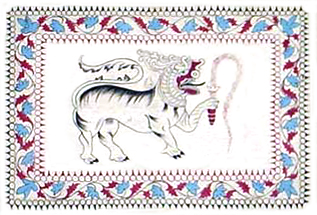
Colombo is the commercial capital and largest city of Sri Lanka. According to the Brookings Institution, Colombo metropolitan area has a population of 5.6 million, and 752,993 in the city proper. It is the financial centre of the island and a popular tourist destination. It is located on the west coast of the island and adjacent to the Greater Colombo area which includes Sri Jayawardenepura Kotte, the legislative capital of Sri Lanka and Dehiwala-Mount Lavinia. Colombo is often referred to as the capital since Sri Jayawardenepura Kotte is within the urban area of, and a suburb of, Colombo. It is also the administrative capital of the Western Province and the district capital of Colombo District. Colombo is a busy and vibrant place with a mixture of modern life and colonial buildings and ruins. It was the legislative capital of Sri Lanka until 1982.

The Jaffna Kingdom, also known as Kingdom of Aryachakravarti, of modern northern Sri Lanka was a historic monarchy that came into existence around the town of Jaffna on the Jaffna peninsula traditionally thought to be established after the invasion of Magha, who is credited with the founding of the Jaffna kingdom and is said to have been from Kalinga, in India. Established as a powerful force in the north, north east and west of the island, it eventually became a tribute paying feudatory of the Pandyan Empire in modern South India in 1258, gaining independence in 1323, when the last Pandyan ruler of Madurai was defeated and expelled in 1323 by Malik Kafur, the army general of the Muslim Delhi Sultanate. For a brief period, in the early to mid-14th century, it was an ascendant power in the island of Sri Lanka when all regional kingdoms accepted subordination. However, the kingdom was eventually overpowered by the rival Kotte Kingdom, around 1450 when it was invaded by Prince Sapumal under the Kotte Kingdom's directive.

Battaramulla is a suburb of the city of Colombo, situated 5.2 miles from the City Centre at Colombo Fort, near the Parliament of Sri Lanka. It is one of the fastest developing administrative, commercial and residential areas in the Colombo District being home to the country's elite. By present Battaramulla has been an important town in Sri Lanka, because of the Sri Lanka government decided to locate all the government department head offices in this town.
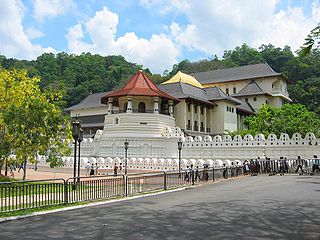
Sri Dalada Maligawa or the Temple of the Sacred Tooth Relic is a Buddhist temple in the city of Kandy, Sri Lanka. It is located in the royal palace complex of the former Kingdom of Kandy, which houses the relic of the tooth of the Buddha. Since ancient times, the relic has played an important role in local politics because it is believed that whoever holds the relic holds the governance of the country. Kandy was the last capital of the Sri Lankan kings and is a World Heritage Site mainly due to the temple.

Upulvan is a guardian deity of Sri Lanka. Sri Lankan Buddhists believe him also as a protector of the Buddhism in the country. The name Upulvan depicts his body colour which means "blue water lily coloured". The cult of Upulvan started during the medieval period in Sri Lanka and later the deity was identified with the god Vishnu of the Hindu tradition. According to the local lore and legend, Upulvan is the god whom the Lord Buddha entrusted with the guardianship of Sri Lanka and Buddha Śāsana of the country.
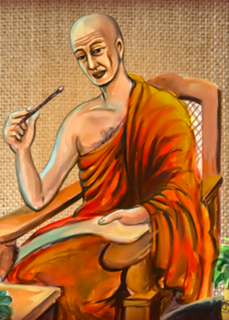
Thotagamuwe Sri Rahula Thera was a Buddhist monk and an eminent scholar, who lived in the 15th century in Sri Lanka. He was a polyglot who was given the title "Shad Bhasha Parameshwara" due to his mastery in six oriental languages which prevailed in the Indian subcontinent. Sangharaja Thotagamuwe Sri Rahula Thera was also a distinguished author, veteran astrologer and a proficient ayurvedic physician.

Magul Maha Viharaya is an ancient Buddhist temple situated in Lahugala, Ampara District of Sri Lanka. The temple lies on the northern edge of the Lahugala National Park, about 22 km off from Siyambalanduwa town and about 11 km off Pottuvil town. Lahugala has been part of the Kingdom of Ruhuna in ancient Sri Lanka. The ruins of Magul Maha Vihara are one of the major tourist attractions of the Eastern province. This temple is also an archaeologically protected monument of the country.

Yatawatte Purana Vihara is an ancient Buddhist temple in Gampaha, Sri Lanka. It lies on Gampaha – Pahalagama main road, approximately 1 km (0.62 mi) away from the Gampaha town. The temple has been formally recognised by the Government as an archaeological site in Sri Lanka. The designation was declared on 15 April 2016 under the government Gazette number 1963.
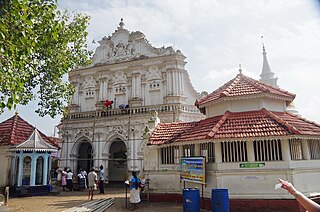
Kande Vihara is a major Buddhist temple in Kalutara District, Sri Lanka. The temple has got its name 'Kande vihara' as it is built on top of a hill located near to Aluthgama town. The temple has been formally recognised by the Government as an archaeological site in Sri Lanka.

Pita Kotte Gal Ambalama is a historic Ambalama building situated at Pita Kotte junction, Western province, Sri Lanka. It was used as a resting place or waiting place for the visitors who came to ancient capital of Kotte kingdom as well as Kotte Raja Maha Vihara. The building has been formally recognised by the Government as an archaeological protected monument under the No.9 of the Government Archaeological Act published in 1940.

Balapokuna Raja Maha Vihara is a historic Buddhist temple situated in Pamankada, Western Province, Sri Lanka. It is located near to the 6th mile post junction on Colombo-Batticaloa main road. The temple has been formally recognised by the Government as an archaeological site in Sri Lanka. The designation was declared on 6 June 2008 under the government Gazette number 1553.

Kotte Raja Maha Vihara is a historic Buddhist temple situated in Sri Jayawardenepura Kotte, Western province, Sri Lanka. It is located near to the historic building Pita Kotte Gal Ambalama at the Pita Kotte junction on Kotte road. The temple has been formally recognised by the Government as an archaeological site in Sri Lanka. The designation was declared on 17 May 2013 under the government Gazette number 1811.

Aramanapola Raja Maha Vihara or Ganegama Rankoth Vihara is an ancient Buddhist temple in Ganegama, Sri Lanka. The Vihara is located approximately 2.5 km (1.6 mi) far away from the Pelmadulla town on Colombo - Batticaloa main road (A4). The temple has been formally recognised by the Government as an archaeological site in Sri Lanka. The designation was declared on 2 March 1951 under the government Gazette number 10217.
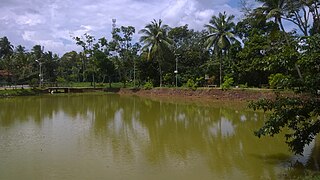
Pathaha Pokuna is an ancient bathing tank or pool situated in Udugampola, Sri Lanka. It is located approximately 0.45 km (0.28 mi) from Udugampola Roundabout and close to the historic temple Uththararama Purana Vihara. The pond has been formally recognised by the Government as an archaeological protected monument in Sri Lanka. The designation was declared on 8 July 2005 under the government Gazette number 1401.

Uththararama Purana Vihara is a historic Buddhist temple situated at Udugampola in the Western province, Sri Lanka. The temple is located on Udugampola – Weediyawatta junction road approximately 0.5 km (0.31 mi) away from the Udugampola Roundabout. The temple has been formally recognised by the Government as an archaeological site in Sri Lanka. The designation was declared on 7 July 2005 under the government Gazette number 1401.

Tempita Vihara is an unique type of image house found in some Buddhist temples in Sri Lanka. Have an inimitable architecture design, Tempita Viharas were popular aspect of many Buddhist temples during the 17th-19th centuries. Construction of Tempita Vihara in or after the 20 century has been not recorded. There are more than two hundred Tempita Viharas have been identified in Sri Lanka to date. Most of the shrines are found in North Western, Sabaragamuwa, Central and Western provinces.




